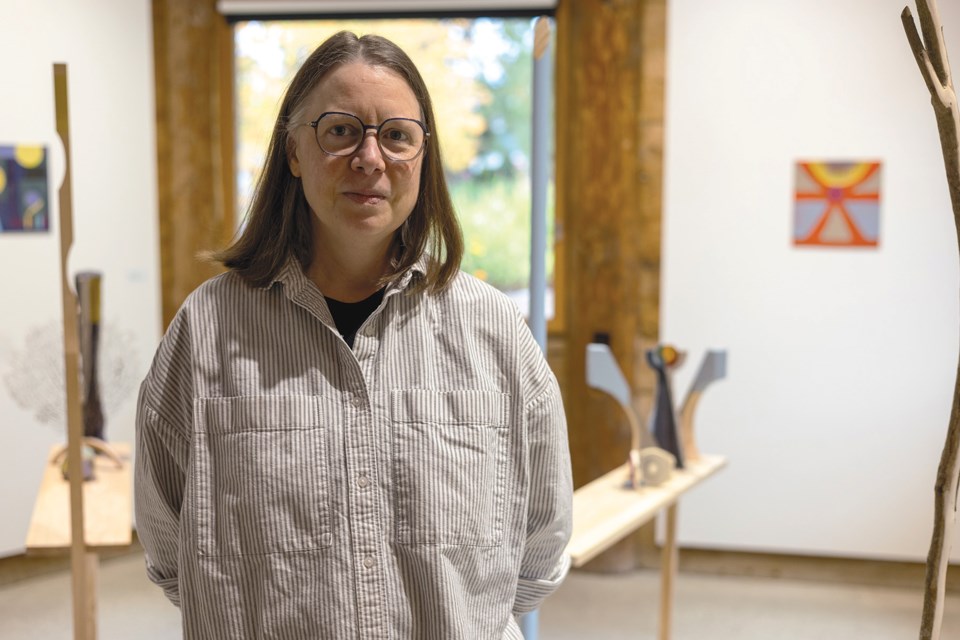An exhibition at the Sunshine Coast Arts Centre provides a three-dimensional language that depicts the act of recollection. Author and artist Colleen Brown — Vancouver-based, but currently in the midst of a three-year residency in Maple Ridge — opened her exhibition States of Mind at Different Times during a reception in Sechelt on Oct. 11.
Brown is a consummate multi-disciplinarian, selecting her axes of expression from an expansive palette. Her sculptures are formed of fabric, sand and stone. She paints abstracts in oils over wooden album covers, harmonizing with acrylics and repurposed plastic material. Even her bright-hued monoprints, like Squishing Up Daisies and Seed Spreader 7, defy rectangular constraints: shoots and tendrils reach beyond right-angled borders like synaptic connections bridging hemispheres.
The works are inspired by her 2023 book If you lie down in a field, she will find you there. The slender volume of essays reflect on her mother’s life and times, seen through the prismatic glass of family memories.
“The book itself is an effort to understand my mother, both as a child but also her historical and cultural place,” said Brown. “She was a religious woman and that’s the place where I find real difficulty in understanding her. I’m not a practicing Protestant but I was raised in that tradition and our dominant culture is a Protestant culture. And so I begin to see things in our culture that are influenced by that.”
Brown observed that many church communities strive to curtail exceptional, unique or unusual behaviours — a tendency she also notes in small communities and Canadian society writ large. In her book, she recalls seeing her own father view a painting with apparent disdain. “As I got closer,” she writes, “I realized Dad wasn’t angry. He was frightened by incomprehension and totally diminished by it.”
There are four recurring primal figures in Brown’s work that illustrate the effect of cultural forces. Her favourite, she admitted, is the “corporeal lump,” which like the others (including the “upright address” and “beckoning display”), demonstrate the relationship of gravity to matter. Once upon a time, sculpture was the most effective way to create lifelike replicas. Now, the mediums of film and photography can more ably represent the surface of things while sculpture delves into more primal, attractive forces.
“I know we don’t consider sticks confrontational but just the very act of something standing up on its own accord, and the way you stand, is making an assertion about itself and about you,” she explained.
Brown’s artworks offer a vision of domestic familiarity — as in her tufted wool Chenille and the calculated assemblage of Storage — while simultaneously evoking the alienness of ritual objects. In Storage, a felt-corseted scepter rises from its base, capped with opposing demi-orbs. Light from the nearby Medusa Street window casts complementary shadows that appear vaguely humanoid.
Brown, who holds degrees from Emily Carr University, Simon Fraser, and New York’s Bard College, is also the general manager of Vancouver Poetry House, a not-for-profit that supports spoken-word artists.
Brown’s figures, like words themselves, have textures and motility of their own. “I want viewers to imagine moving things around,” she said. “They don’t need to actually move them but I don’t screw things down. You can potentially imagine putting them in a different place. And that, to me, seems a lot like our minds.”
States of Mind at Different Times remains on display at the Sunshine Coast Arts Centre until Nov. 9.



